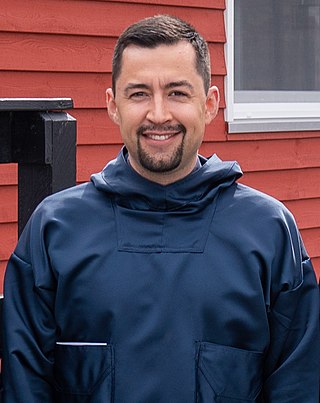Telecommunications in Chad include radio, television, fixed and mobile telephones, and the Internet.
Telecommunications in the Falkland Islands includes radio, television, fixed and mobile telephones, and the Internet.

Greenland is a North American autonomous territory of the Kingdom of Denmark. It is the largest country within the Kingdom and one of three countries which form the Kingdom, the others being Denmark proper and the Faroe Islands; the citizens of all three countries are citizens of Denmark. As Greenland is one of the Overseas Countries and Territories of the European Union, citizens of Greenland are also granted European Union citizenship. The capital and largest city of Greenland is Nuuk. Greenland lies between the Arctic and Atlantic oceans, east of the Canadian Arctic Archipelago. It is the world's largest island, as well as the northernmost area of the world – Kaffeklubben Island off the northern coast is the world's northernmost undisputed point of land, and Cape Morris Jesup on the mainland was thought to be so until the 1960s.
Telecommunication in Honduras started in 1876 when the first telegraph was introduced, continued development with the telephone in 1891, radio in 1928, television in 1959, the Internet in the early 1990s, and cellphones in 1996.
Telecommunications in Namibia include radio, television, fixed and mobile telephones, and the Internet.
Telecommunications in Togo include radio, television, fixed and mobile telephones, and the Internet.
Telecommunications in Albania include radio, television, fixed and mobile telephones, and the Internet.
Telecommunications in Bhutan includes telephones, radio, television, and the Internet.

Kalaallit Nunaata Radioa, also known by its abbreviation KNR, is Greenland's national public broadcasting organization.

The Greenland Airports is the national airport operator of the airports in Greenland, in charge of airport upgrades and associated fees and taxes in all airports in Greenland.

Law enforcement in Greenland, an autonomous country of the Kingdom of Denmark, is provided by Kalaallit Nunaanni Politiit an independent police district of Naalagaaffiup Politiivi, within the National Police of Denmark. Since 2006, Greenland has constituted one of the 12 police districts of the Rigspolitiet, headed by the chief constable known as the Politiit Pisortaat based in Nuuk, the capital of Greenland.

Tusass is a Greenlandic postal and telecommunications company dating back to 1879. Tusass is the largest telecommunications company in Greenland. The company's headquarters are located in Nuuk.

KANUKOKA was the national association of Greenland's municipalities, led by Palle Jeremiassen. The name was an acronym formed from the first two letters of each of the constituent words of the now defunct organization's name in the Greenlandic language.
Stephen Heilmann was a Greenlandic politician and journalist.
Aki-Matilda Tilia Ditte Høegh-Dam is a Danish-Greenlandic politician, who is a member of the Folketing for the Siumut political party. She was elected into parliament at the 2019 Danish general election, entering parliament at 22 years old, becoming its youngest member.

Múte Inequnaaluk Bourup Egede is a Greenlandic politician currently serving as the seventh prime minister of Greenland, a position he has held since April 2021. He has served as a member of the Inatsisartut, the parliament of Greenland, since 2015, and furthermore as chairman of the Inuit Ataqatigiit party since 2018.
Sofia Johanna Geisler is a Greenlandic politician and journalist.
Nemo Thomsen is a Greenlandic association footballer who currently plays for Young Boys FD and the Greenland national team.
The spiral case is an ongoing investigation into a birth control campaign by Danish government in Greenland, primarily during the 1960s and 1970s. Often without consent and under the direction of Danish government officials, Danish doctors placed intrauterine devices in thousands of Greenlandic Inuit girls and women. The program was created to control Greenland's birth rate.
Rene Eriksen Petersen is a Greenlandic footballer who plays as a forward for Faroe Islands Premier League club Klaksvíkar Ítróttarfelag, and the Greenland national team.









